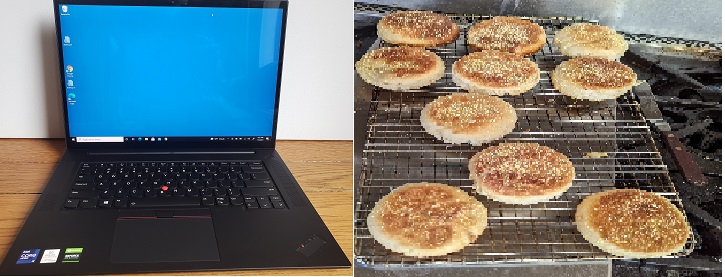Lenovo Miix 510 Review
This review is an analysis of the 12.2” Lenovo Miix 510, a 2-in-1 PC. The target audience is the mobile user who needs to combine functionality that would more normally be found in a Windows tablet with features normally found in a compact laptop. Windows tablets typically offer light weight and portability with the capability to run many of the same applications as a desktop computer and to share data easily with other Windows machines. Tablets normally allow screen rotation; they have touch screens and provide some sort of data entry capability via pop-up keyboard. They generally have rear-facing cameras, so that the screen could be used as the camera’s view-finder. Other tablets I have used tended to sacrifice in the areas of processor speed, memory and permanent storage (hard drive or SSD). Laptop computers tend to have keyboards and touchpads as their primary input devices. They tend to have faster processors, and more disk and RAM storage. Laptops tend to have front-facing cameras for video calls and “selfies”.
The machine being reviewed is based on an Intel i5-6200 sixth-generation Skylake CPU and comes with 8 GB of DDR4 memory. It has a bright 12.2” IPS FHD screen. Graphics functions relied on the Intel HD Graphics 520 functions built into the CPU. There was one “normal” USB3 port and one USB3 type-C port. There was also an audio combo jack. Along the bottom of the machine, there is a connection for the plug-in backlit keyboard. Networking is handled by a Qualcomm Atheros QCA9377 adapter that combines wireless AC with Bluetooth 4.1. The machine came loaded with Windows 10 Home. For storage, the computer has a fast and roomy Samsung NVMe MZVLV512 512GB SSD. The machine also has a 2-megapixel front camera and a 5- megapixel auto-focus rear-facing camera. The bottom section of the rear cover folds out to make a sturdy stand. The specs are comparable to what would be expected on a well-equipped modern laptop, and there were advanced features that I would not have expected to find on a Windows tablet. There was no reason that someone needing a powerful laptop for travel, couldn’t rely on this machine, and also enjoy the flexibility of having a tablet.
Without the keyboard, the machine weighed 867 gm or 30.6 oz. With the keyboard, it weighed 1237 gm or 43.7 oz. The weights do not include the charger, and there will be slight variations depending on configuration.
The keyboard is attached by magnets which hold it securely and help to guide it into place. It is easy to install, and there is some angle adjustment available by playing with the rear stand, but less than what would be available with a 1-piece laptop. I did not find the lack of adjustment to be a serious problem for most kinds of use, but more stability might be better if it were really being used in laptop mode, while sitting on a lap.
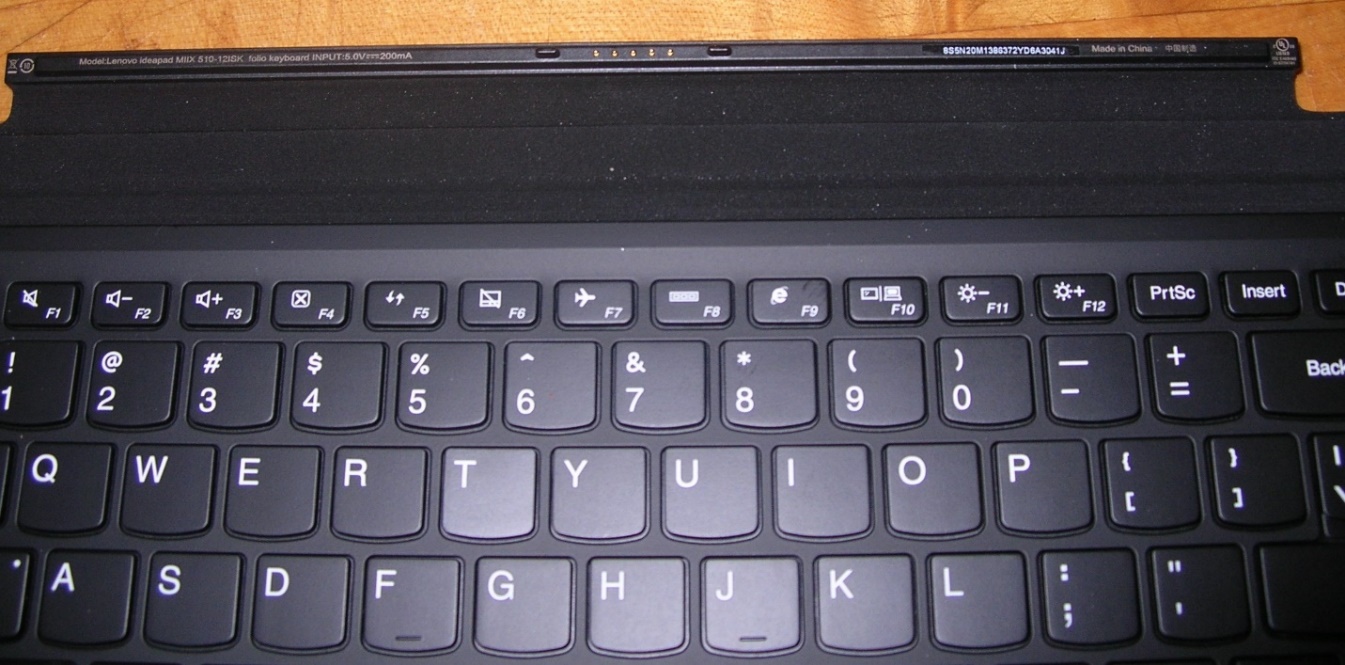
Figure 1 :Keyboard connector
The machine had an attractive silver finish that showed off the sturdy stand.
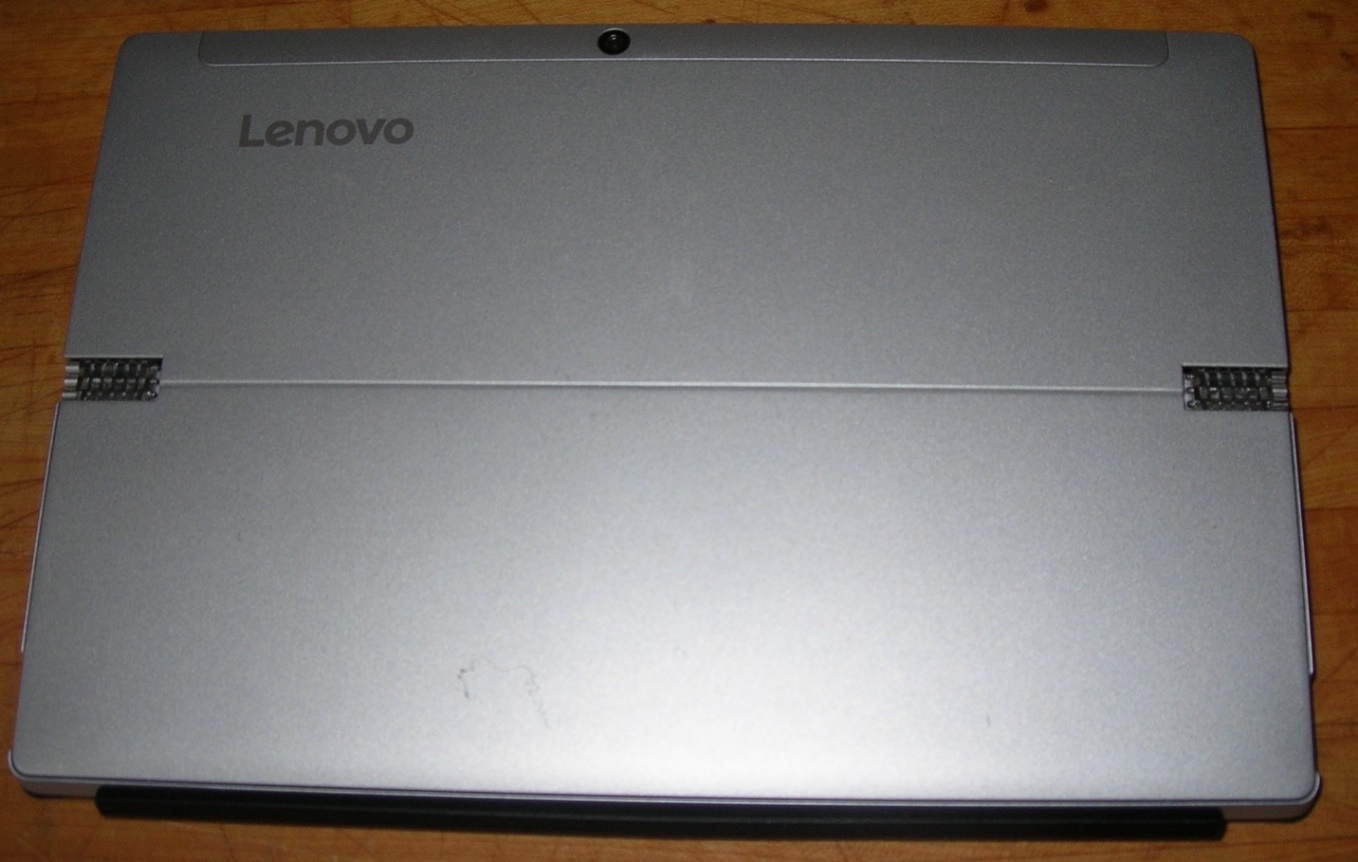
Figure 2:Rear case
My first impressions were positive. After unpacking, before I turned it on, I inspected the machine for any shipping damage or visible defects and found none.
I then set the machine up as a laptop, and plugged in with the keyboard attached. I booted into the BIOS to set the date and time, and to confirm that the processor, memory and disk storage were as expected. I then booted normally and connected the machine to my Lenovo ID and Microsoft ID. I installed Office 365 and tested those applications. As I expected, everything worked correctly; Office tends to run on any Windows computer. I was impressed with the clarity and viewing angles from the IPS screen. The Miix 510 has a glossy (rather than matte) screen. I find the colors sharper and more vivid on the glossy screen. If I planned to use the machine outdoors in direct sunlight, I would prefer a matte screen, as matte screens eliminate a lot of glare. I will use it indoors.
In laptop mode, the machine looks like a normal, compact laptop.
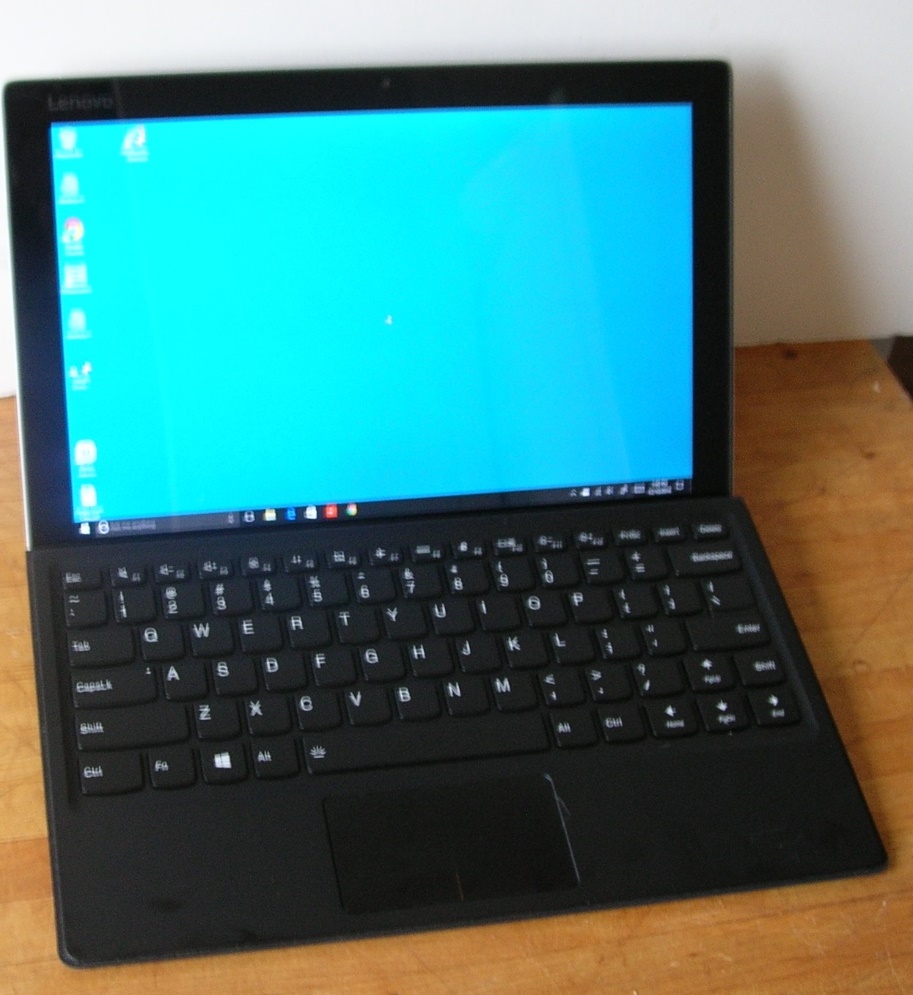
Figure 3: Laptop mode
If you remove the keyboard and start the machine, it works like a normal Windows tablet. I turned on auto-rotate and the machine switched back and forth between landscape and portrait mode automatically.
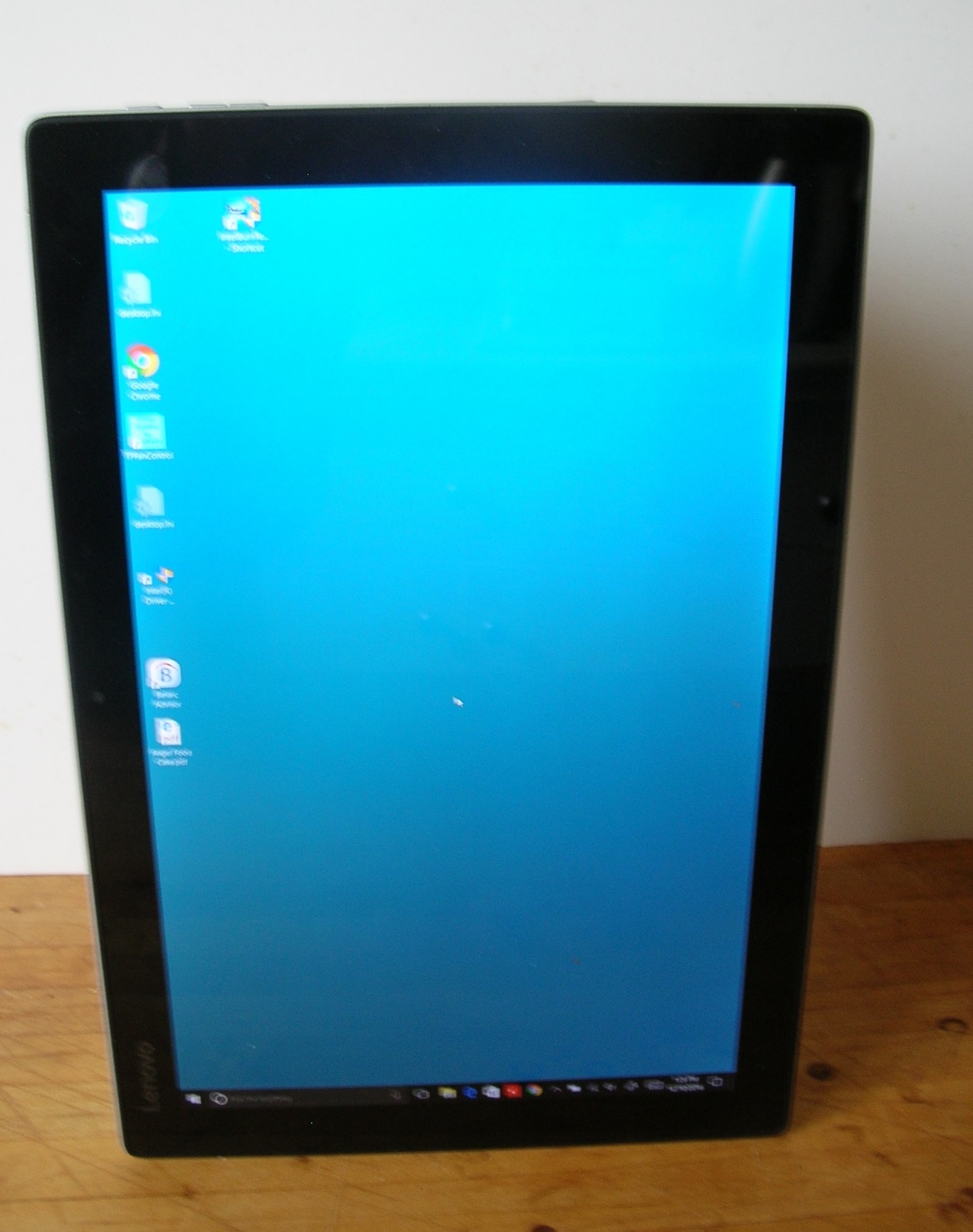
Figure 4: Tablet mode
A few years ago, I was interested enough in trying a convertible machine to go out and buy one. I got a Lenovo IdeaTab Lynx and played around with it for a while. The machine seemed underpowered for many things I might do. It had an Intel Atom processor, which had good performance for a tablet, but well below average for a laptop. It came with windows 8.1, but with only 2GB of memory, it was limited. There was 64GB of SSD storage, which didn’t leave much room after the operating system was installed. Again, it was fine for a tablet, but it could not be used as a laptop replacement. The keyboard was connected via a port on the bottom, and it had a good sturdy hinge that allowed variable screen angle. I was surprised that the Lynx did not have the rear-facing camera, that I would expect on a tablet. For me, the biggest issue on the Lynx was security. I use a password manager to keep IDs and passwords synchronized on computers I use, and rely on a computer’s security features to safeguard that information. For portable machines, I use disk passwords to secure access to my data. If I have a laptop stolen, I am not so concerned that the thief can reuse the machine, but I am concerned that my personal information might be accessed. Disk passwords put on through the BIOS are generally considered uncrackable. The Lynx supported disk passwords, but it required the keyboard to be attached to enter the password. I needed to have the keyboard with me if I wanted to turn on the computer, so I couldn’t go out carrying only the tablet portion. This meant that, for me, it was just an underpowered laptop.
All of the issues I mentioned with the Lynx seem to be corrected in the Miix 510. The Core i5 Skylake processor with 8GB of DDR4 RAM is sufficient to run almost anything. The 512GB SSD is ample for normal use. I would give the same warnings I would give with any laptop: It is not the best choice for high-speed full-motion games or large-scale video editing. The rear facing camera took very good pictures and the autofocus worked without my needing to think about it. I do occasionally use the front-facing camera for video conferences and the like, but I tend to avoid them. All the cameras I have tried tend to show an image of someone much older than I am, and not nearly as good-looking. I had the same complaint with the Lynx. Within those limitations, the cameras on the Miix 510 were fine. Regarding security, if the disk is password-protected and you start the machine without the keyboard attached, a touch keyboard pops up on the screen to allow password entry.
The screen is an FHD+ (1920X1200) IPS LCD with 10-point MultiTouch. In reading the specs, I was surprised to see the 16:10 aspect ratio, as most other panels are 16:9 (such as 1920X1080, which is called FHD). I am not sure of the technical reasons favoring one aspect ratio over the other, but I can say that I was very impressed with the screen. The display seemed clear and bright at a wide range of viewing angles. I played a 1080P movie and everything was sharp and clear, with no stuttering or other problems.
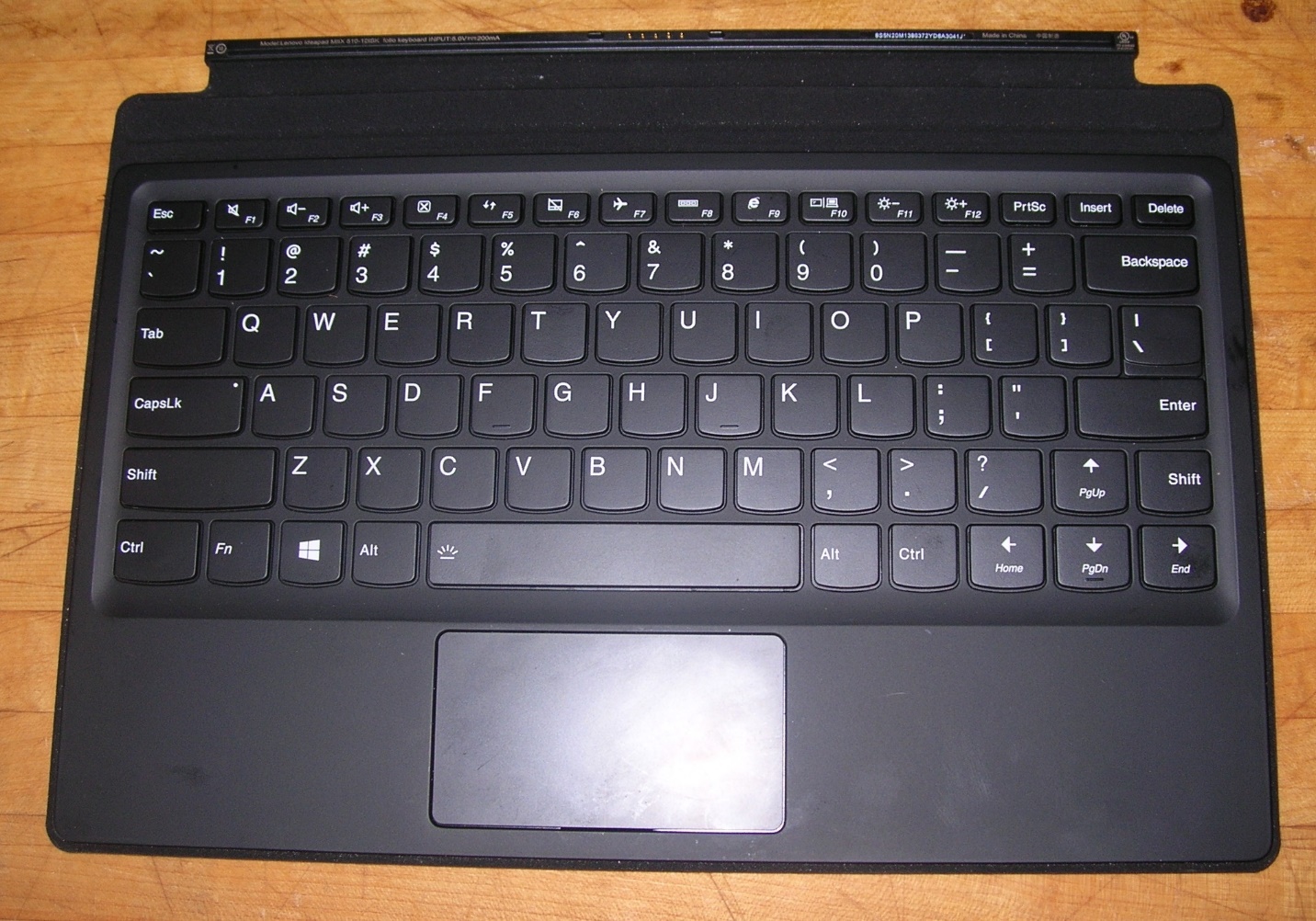
Figure 5: Keyboard and palmrest
The keyboard has 80 keys. The keys, themselves, are full-sized. Some common keys, like page up, page down, home and end are combined with other keys, using the Fn key to distinguish them. I usually prefer keyboards with a noticeable click and more travel, the kind often called gaming keyboards, but I had no trouble using the Miix’s detachable keyboard. The touchpad had good sensitivity, and I had no trouble with cursor movement or clicks due to inadvertent brushes while typing.
People frequently ask me about “upgradability”. In general, laptops are less upgradable than desktops, and compact laptops are less upgradable than larger ones. As computers get smaller and thinner, memory, CPUs and sometimes even disk storage cannot be changed as they are integrated or soldered onto the motherboard. In the Miix 510, CPU and memory are soldered and the SSD is a separate M.2 card, but you should probably consider it to be non-upgradeable. The battery is inside the machine and cannot be disconnected without opening the case. If you open the case (not trivial) you are likely to pull out the LCD and touch cables before you can disconnect the battery. I would expect that playing with LCD cables in a powered machine could easily blow a motherboard fuse or cause other damage.
I always want to be sure I won’t run into a problem related to overheating or excessive fan noise. For testing, I often use TPFanControl to monitor temperatures, but being free software, it often doesn’t support newer hardware. In this case, I used OpenHardwareMonitor (another free program) to monitor temperatures. I ran Prime95 to exercise the CPU and watched the temperatures. After about 15 minutes, the temperatures stabilized around 62C, which showed there was no heat problem. The fan became noticeable, as expected, but I did not find it to be excessively loud

Figure 6: Prime95 and OpenHardwareMonitor
I use CrystalDiskInfo to measure disk throughput. The raw numbers don’t translate well into real-world speed, but when you test two different machines with similar drives, or test 2 different drives in the same machine, you can compare the scores and bigger numbers are better. I have a ThinkPad P70 with a similar PCIe SSD so I ran benchmarks on both machines.
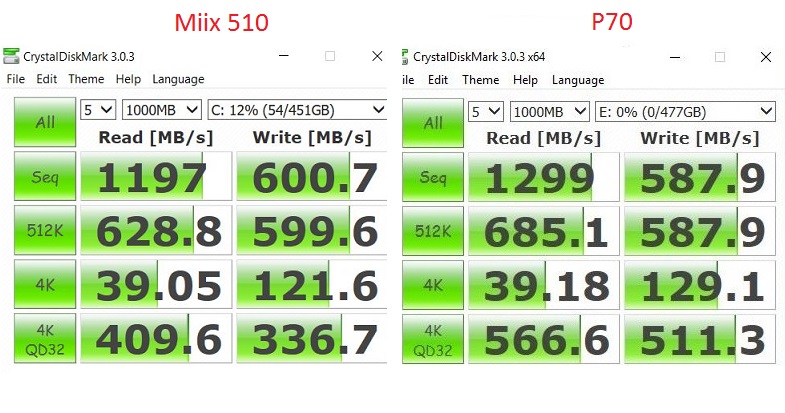
Figure 7: SSD test
As you can see, most categories had similar scores. I think scores within 10% can be treated as the same. The one labeled 4K QD32 was substantially faster on the P70. I’m not really an expert, but I believe that category relates to data read or written in 4K blocks when there are lots of threads (up to 32) all requesting data at the same time. With that in mind, one would expect the P70 to be faster because it has a quad-core CPU, so it can work on more threads at the same time.
I didn’t run the battery all the way down to see how long it would run, because battery life is so dependent on the actual work being done. I played a movie that was slightly under 2 hours long. I then used the machine for web surfing and similar tasks for about an hour, and then I played the movie again. At the end, Windows 10 thought there was about 45% of the battery life remaining. I did these tasks without going to any extra effort to lower the backlight brightness.
A big advantage of a convertible computer is flexibility; one machine can serve as a laptop and as a tablet. This is especially true in the Miix 510, because it really has as much computing power as a modern, high-end laptop, so you can use it to watch a movie while exercising at a health club, or to check email before going to sleep.
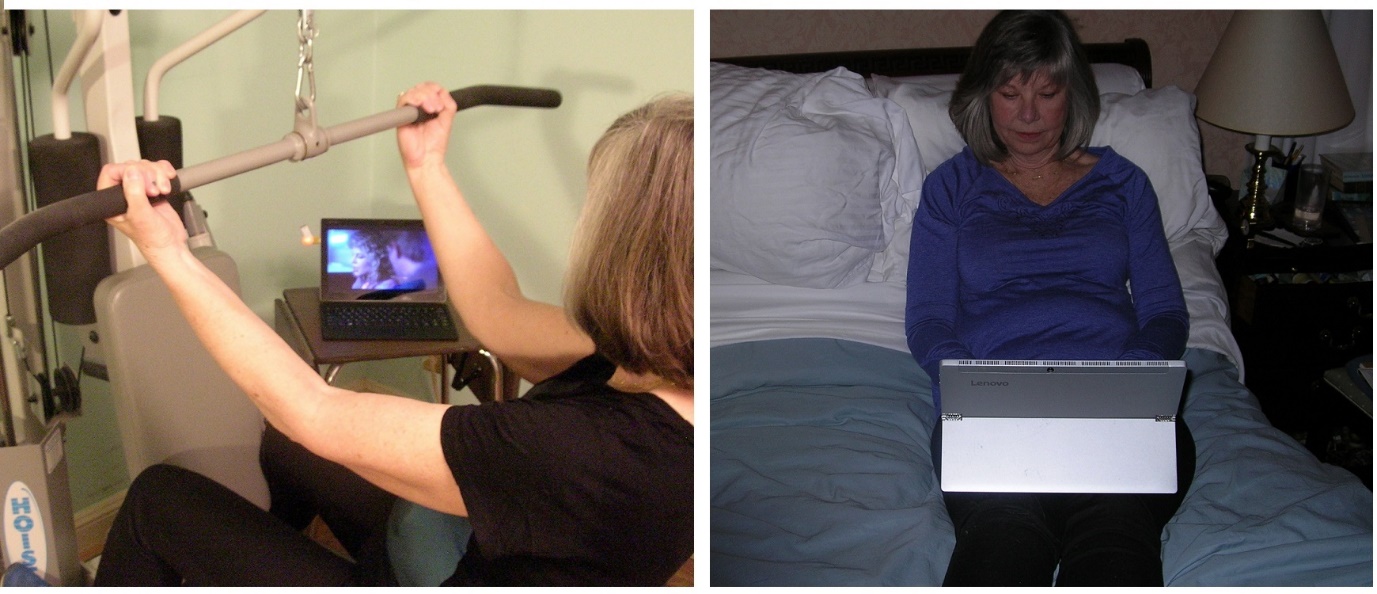
Figure 8: Usage
You can use it to follow a recipe while cooking or to read a book in a comfortable chair, whether in a hotel lobby or in your own living room.
These were just a few ideas. It seemed to me that anything that could be done with a Windows tablet or anything that could be done with a Windows laptop would be fine.
I liked the machine a lot. It seems like a mature product as opposed to the Lynx I used to have, which was more like a work-in-progress. The Lynx was less useful as a laptop than a real laptop, and it was not as good a tablet as a stand-alone tablet.
There is always something that I would like to see changed in the next model. I really liked the rear stand, but I would like it better if it were a trapezoid shape, rather than a rectangle. If you look at the picture of the cook glazing a cake, you can see the machine standing up in tablet mode. With the rectangular shaped stand, the tablet stands vertically; a trapezoid shape would allow the tablet to tilt back a little, making it more stable (harder to knock over) and also easier to read.
